ABSTRACT
In earlier days, children used to play in outdoors with plant parts and their products for fun making and games. However with modernity and advancement in science and technology, this indigenous knowledge is vanishing day by day. There is no scientific documentation of plants being used for fun and games by children. The present study carried out in different tribal and non-tribal village schools of Koraput and Khordha districts of Odisha, India in a systematic manner documented 90 plant species distributed in 85 genera spread over 44 families. The plant species recorded include 35 trees, 21 shrubs, 24 herbs and 10 climbers/creepers. The plants widely used as play material include Artocarpus heterophyllus, Dendrocalamus strictus, Cocos nucifera, Calotropis gigantea, Ficus benghalensis, Mangifera indica, Musa paradisiaca, Phoenix sylvestris, Tamarindus indica, etc. The different plant parts such as leaves, fruits, flowers, seeds etc. and their mode of use by the participating respondents have been recorded and discussed. It was noted that the most and frequently used plant parts as the source of play were fruits followed by leaves, flowers, and seeds. The economic importance of plants, besides their implications in teaching and learning along with their sustainable utilization and conservation is discussed.
Keywords: Plant biodiversity, conservation, fun, modernity, advancement, technology, utilization.
The environment is the sum total of all components and factors that influence the life of an organism including human being from birth to death. One of the major concerns of the environment today is the loss of biodiversity that includes varieties of plants, animals, and microorganisms that exist on the surface of planet Earth (Baliga, 1996; Satapathy, 2007). This rich biodiversity of life has ever been instrumentalin providing humanity with food security (Swaminathan and Bhavani, 2013), shelter, health care, and to certain extent, industrial goods and livelihood leading to improvement in people’s standard of living in the modern world. Further, biodiversity has played a unique role in the evolution and differentiation of various species. It sustains the system we live in and forms a part of our daily lives and livelihood and constitutes resources upon which families, communities, nations and future generations do depend (Chavan et al., 2016). Worldwide, ten thousand species of higher plants and several hundred lower plants are currently used by human beings for a wide variety of purposes such as, household items, rituals, food, fuel, fiber, medicines, oil, spices, and as forage and fodder of domesticated animals (Haywood, 1992). Trees are the symbol of environmental as well as socio-economic sustainability of the globe (Chavan, 2016). Traditionally, trees are being used for the interdependent benefit of 6Fs: food, fruit, fodder, fuel, fertilizer and fibre. The multivarious benefits and services generated from tree-based systems have helped to improve the livelihood of people globally, directly or indirectly. As such it sustains the lives we lead and the societies we form (Dutta, 2007; Silver, 1991). Many investigations have been carried out pertaining to the economic and socio-cultural values (Khoshoo, 1994) of plant diversity such as food resources (Mohanty et al., 2013; Rout et al., 2007), source of medicines (Subudhi, 1992; Pattanaik, 2008; Panda, 2010; Kumar and Satapathy, 2011; Mohanty et al., 2015), sustaining livelihood (Chavan, 2016), rituals (Mohanty et al., 2011), and cultural functions. However, no study has been made to understand their educational importance in terms of plants being used for fun and games. Under this background, the present study has been carried out with the following objectives: i) to identify and document plant species used for fun and games from local biodiversity; ii) to know the plant part being used and the nature of its use; iii) to find out the economic value, if any of the plants identified.
The present study was carried out in two districts, Koraput and Khordha of the State of Odisha. Koraput is located (18°13’ to 19°10’ N, 82°5’ to 83°23’ E) in the Southern part of Odisha, which is mostly tribal dominated with alow literacy rate. Khordha district stands (19°40’ to 20°25’ N, 84°40’ to 86°5’ E) in the eastern part of the state and mostly influenced by modernity (Figure1).Twenty elementary and secondary schools were selected from each district for the present study. Ethnobotanical information of plants used for games, fun, and play was gathered through survey, structured oral interviews and informal conversation with school children, teachers, and local people (Huntington, 2000; Mohanty, 2011). The information included the local name of the plant, plant part, nature of its use, habitat of the plant etc. All the gathered information was cross checked with students and parents of the nearby schools. Besides fun and games, other economic and medicinal values of the plants, if any, were also recorded from the students, parents, and teachers. Ethnographic qualitative methods were used to summarize the major themes and categories of information collected from the respondents.The plants along with their part(s) were collected and brought to the Department of Botany, Regional Institute of Education (NCERT), Bhubaneswar for identification. The plants were identified (Table 1) following the Flora of Odisha (Saxena and Brahman, 1996). The herbarium of collected plants is available in the Botany Section (Department of Education in Science and Mathematics) of Regional Institute of Education, Bhubaneswar. The structured interview included the following open-ended questions, such as: 1) Do you play outside and make fun with plants? 2) What game do you play? 3) Which plant do you use to make fun? 4) what is the local name of the plant? 5) Where is the plant seen? 6) What kind of plant it is (tree/herb/shrub/climber/creeper)? 7) Which plant part do you use for play or fun? 8) When does the plant flower and bear fruits? 9) Any economic use of the plant you know besides as play material? 10) Can you demonstrate the fun you make with the plant?

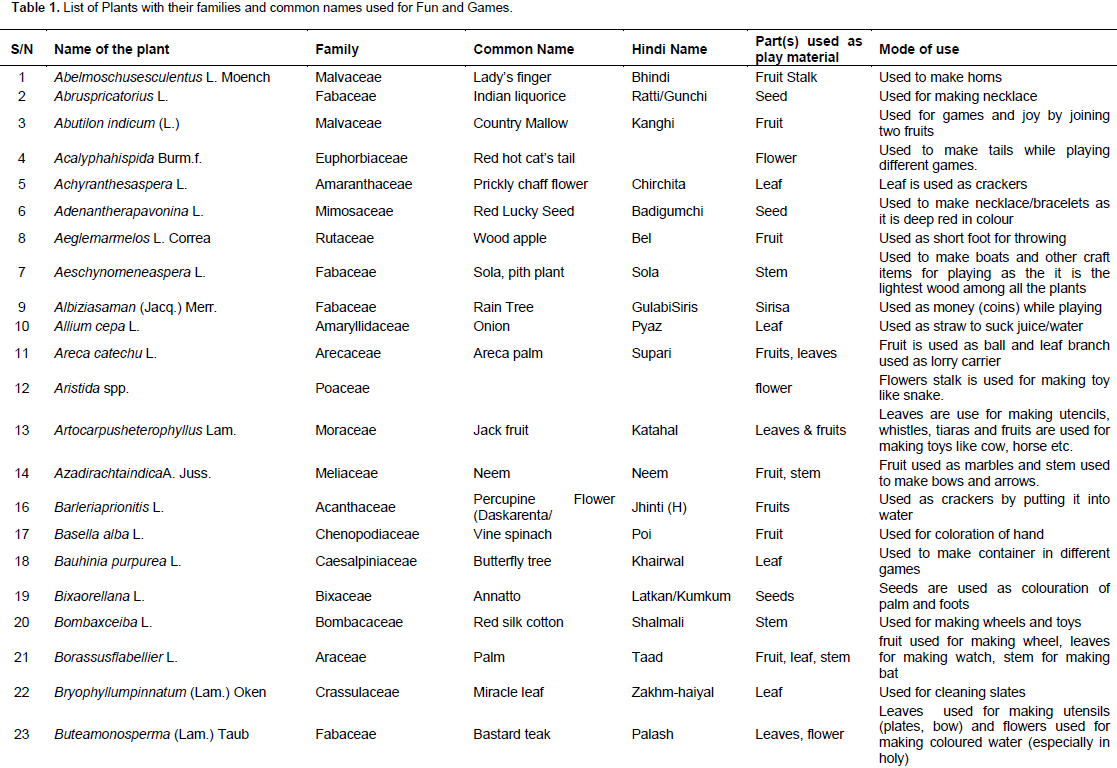
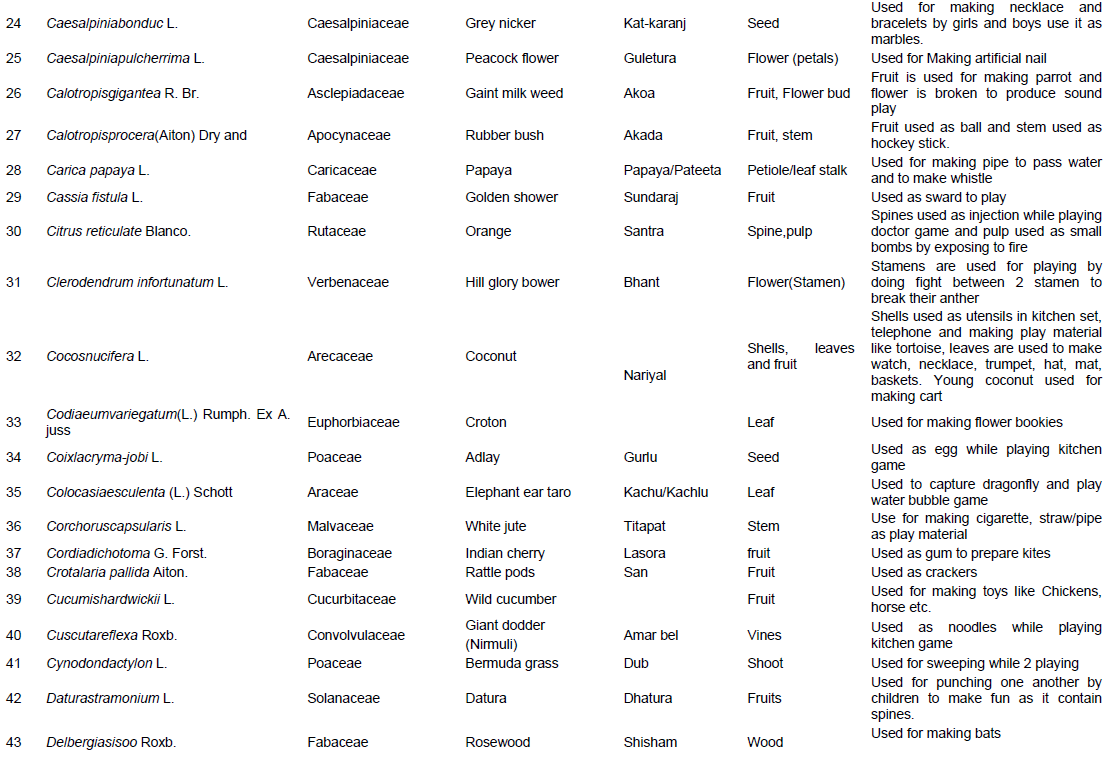
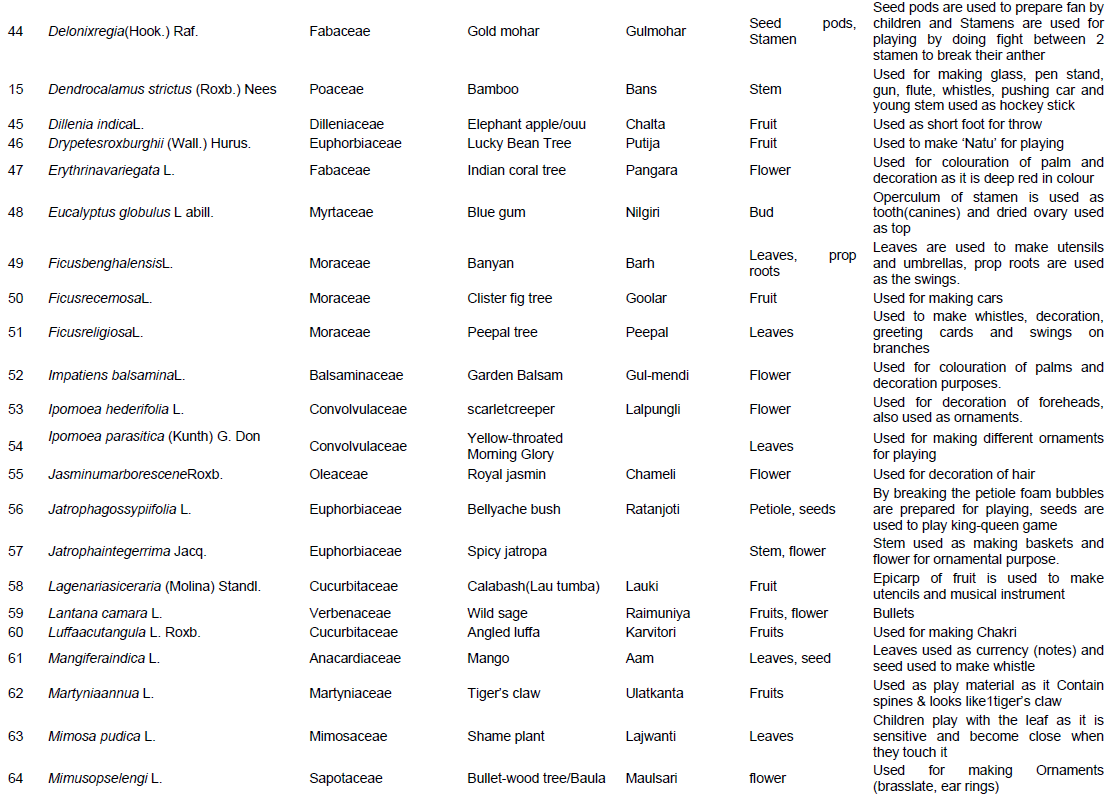
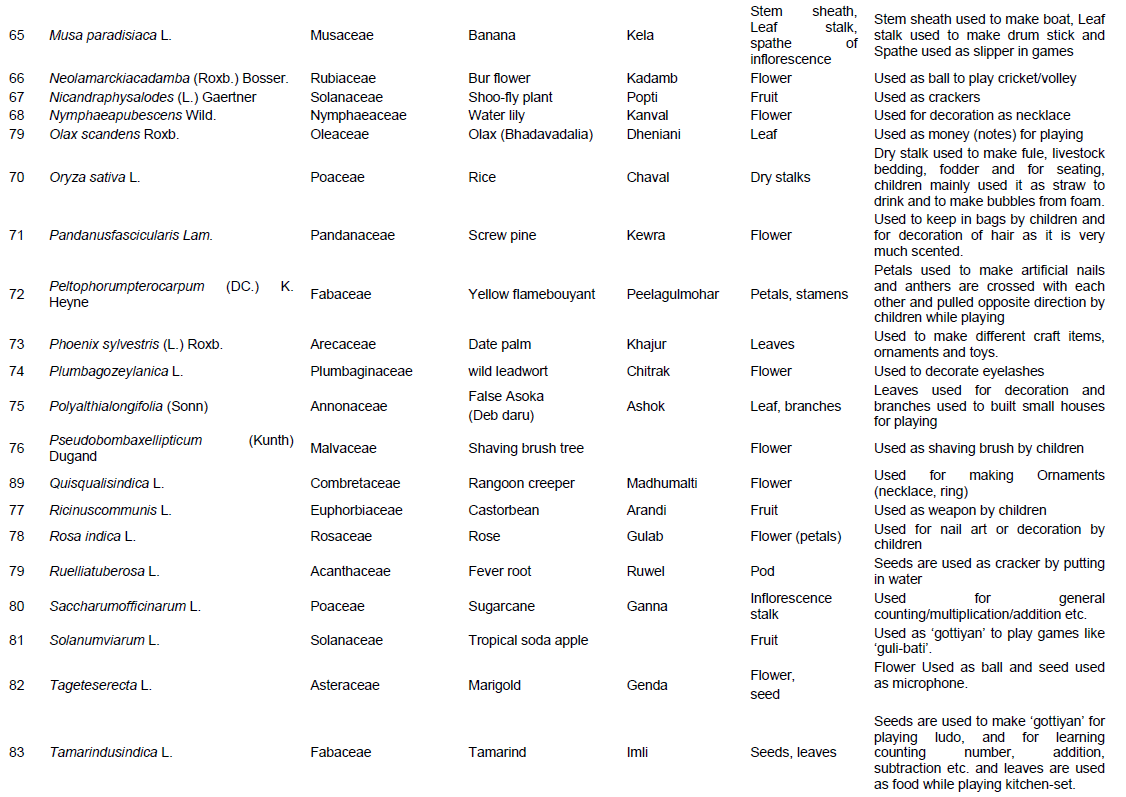

Learning occurs in a joyful environment. Teaching should explore the joyful environment in order to promote learning among children through creative activities (NCERT, 2005). As such learning takes place through child’s interactions with the environment, nature, things, and people around them. Discoveries and inventions are based on keen observations and happenings in nature. As such, environment in terms of plants, animals, soil, water etc. not only provides materials for fun and games but also provide opportunities to learn and discover. Children learn language and skills by observing and describing the leaves, flowers, and fruits; and exploring the patterns that they observe in nature around them.
Objective 1
To identify and document plant species used for fun and games from local biodiversity
The reconnaissance survey included some selected schools and villages of tribal and nontribal regions and some 90 plant species used for fun and play. These are distributed in 85 genera belonging to 44 different families (Table 1). The largest number of plant species are distributed under family Fabaceae (11), followed by Euphorbiaceae (8) and Poaceae (6) (Figure 2). The plants used for fun and games are distributed in 35 trees, 21 shrubs, 24 herbs and 10 climbers/creepers (Figure 3). Some common plants that are frequently used by the children for making play materials include: Artocarpus heterophyllus, Dendrocalamus strictus, Cocos nucifera, Calotropis gigantea, Cucumis hardwickii, Ficus benghalensis, Ficus recemosa, Ipomoea parasitica, Mangifera indica, Musa paradisiaca, Phoenix sylvestris, Polyalthia longifolia, Tamarindus indica, etc (Figure 4).
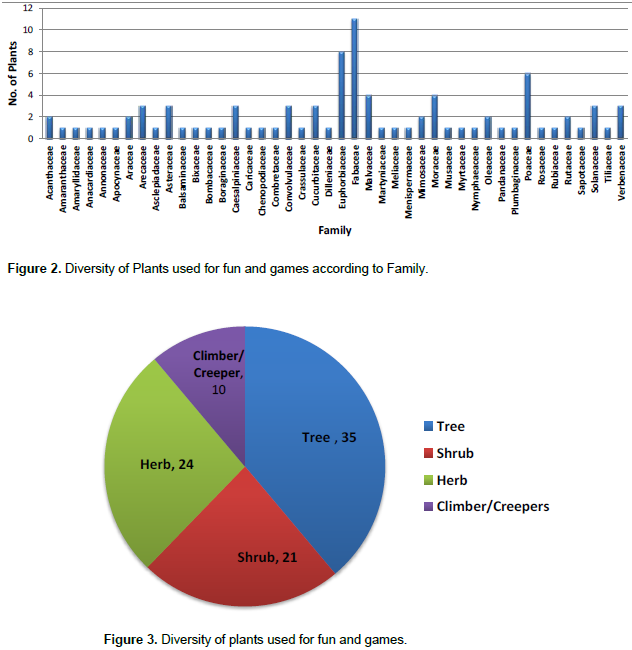
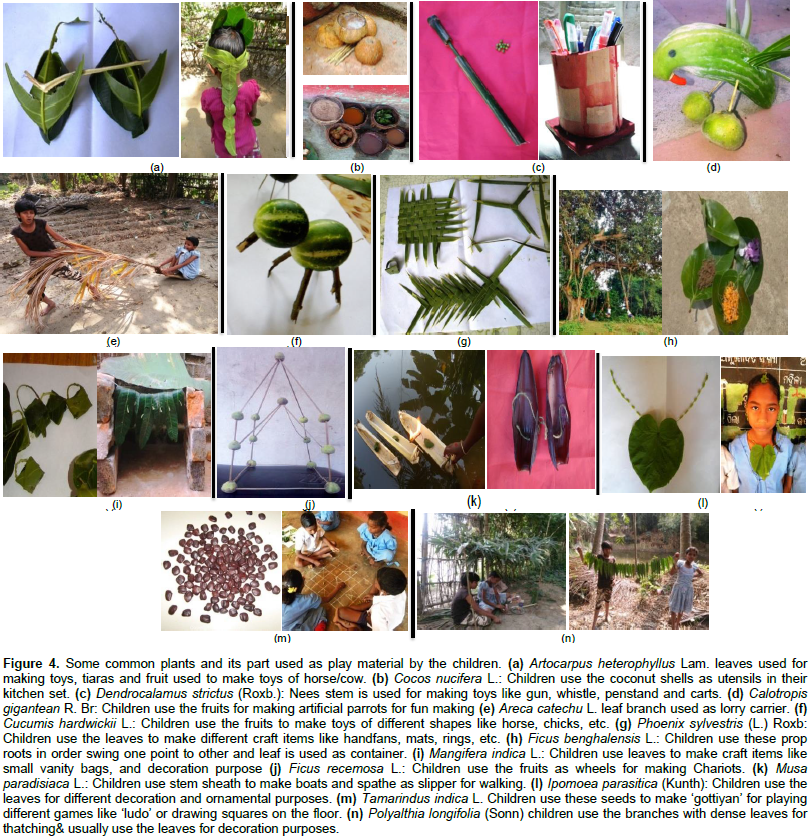
Objective 2
To know the plant part being used and the nature of its use
The plant part(s) and mode of their use as play material were also recorded. It was noted that fruits from most plants species were used for games followed by leaves and flower (Figure 5). The stem is the least used plant part. There are also some plants species in which both flower and fruits, fruits and leaves, leaves and fruits were used for making toys and other play materials. The nature of their use has been explained briefly in Table 1.
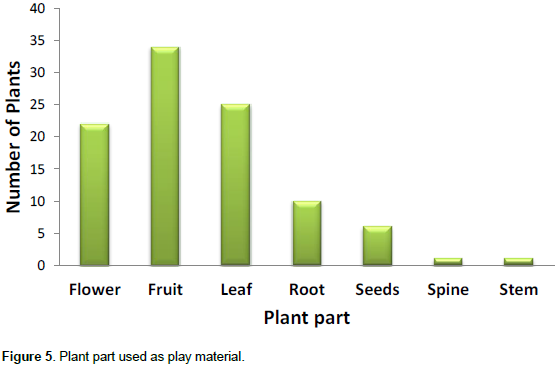
Objective 3
To find out the economic value, if any of the plants identified
Among the plants documented for fun and games, some plants were found economically and socially relevant for the local inhabitants. Some plants are used as herbal medicines and others are consumed as food, few are used for building houses, firewood and marketing purposes. The plants like, Achyranthus aspera, Aegle marmelos, Azadirachta indica, Bryophyllum pinnatum, Calotropis gigantea, Cynodon dactylon, Lantana camara, Mimosa pudica, Solanum viarum, Tridax procumbens, etc are commonly used as herbal medicine by the local people for their primary treatments such as vomiting, dysentery, toothache piles, itching, wounds, stomach and skin disorders (Bisoi and Panda, 2015). Besides being used as play materials, the plants having food value include Abelmoschus esculentus, Allium cepa, Artocarpus heterophyllus, Basella alba, Carica papaya, Citrus reticulata, Cocos nucifera, Dillenia indica, Mangifera indica, Lagenaria siceraria, etc. that are consumed as fruits and vegetables by the local people. Aegle marmelos, Azadirachta indica, Ficus benghalensis, Ficus racemosa and Ficus religiosa are the major trees species which are having religious importance and worshiped by the local villagers and remain conserved (Choudhury and Pattnaik, 1982). Multiple uses of the plants observed in the present study have been depicted in Figure 6.

General perspectives
From the present study, it was observed that nature especially plants do provide ample opportunities for children to make fun and games. Creative skills are reflected through activities such as designing of chariots by joining fruits of Ficus tree, and from boat preparation by using banana (Musa) stem sheaths. These exemplary activities are culturally built up in families. Using plant parts, children design creative games during as well as beyond school hours with the knowledge gained from peers, family and community members. Teachers use the plant parts (seeds, fruits, leave etc.) in teaching of science and mathematics concepts in the classrooms that is hard to transact. Such activities make learning joyful, effective and durable (Satapathy and Dash, 1994). In India, the use of trees and their parts such as flowers and fruits have been used in folk songs, folk proverbs, and folk talks has been reported (Agarwala, 1981). However with urbanization, there is degradation of the environment and accelerated loss of biodiversity; consequently, this culturally-established, indigenous knowledge of using plants for various purposes is getting lost over time (Balick, 1996). The cultural knowledge that is available in one locality may not be the same as at other places, because of divergence in the flora and fauna, and people’s association with those. Further, with developments in science and technology, present generation children are more engaged in computers, mobile phones, internets, videogames, rather than with plants in gardens and parks.
As such, they are away from nature and have little or no concern for it. The indigenous knowledge gathered over the years is increasingly being eroded. In modern schools and urban pockets, students are completely away from nature and see the plants virtually through computers with support from ICT. As such, it is often noticed that children who are isolated from nature, and spend more time in front of computer screens, face problems such as obesity, irritability, laziness, lack of concentration, aggressive behavior and high frustration levels. Hence there is an urgent need to conserve the plants that are not only economically important but also used as fun and games by children, as well as encouraging them to become more engaged with their natural environment. Further, there is a need for additional studies of more plants that are used as fun and games. Internationally, UNO has declared 2011-2020 as the decade of Bio-diversity conservation in order to create awareness about biodiversity, its importance, and conservation (Kulkarni, 2012). As all genetic resources of living things are useful in one form or the other (Swaminathan, 1989), plants and their parts of interest to children that have educational value in terms of teaching-learning material(s) should be preserved and kept in educational institutions for use as demonstrations and to encourage inquiry learning during teaching of scientific concepts.

The authors declare there is no conflict of interests.
The authors wish to acknowledge with thanks, the Principal, Regional Institute of Education (NCERT), Bhubaneswar for extending support for the present study, NCERT, New Delhi for the financial assistance for the purpose and children and teachers from Koraput and Khordha districts for sharing their ethno-botanical knowledge during the survey.
REFERENCES
|
Agarwala SR (1981). Trees, Flowers and Fruits in Indian folk songs, folk proverbs and folk talks.In Glimpses of Indian Ethnobotany.Oxford and IBH Publishing Co. Ltd. New Delhi. pp. 3-12.
|
|
|
|
Baliga BB (1996). Environmental concerns in the late nineties of the present century. Sci Cult. 62(5, 6):107-109.
|
|
|
|
|
Balick MJ, Cox PA (1996). Plant, People and Culture.The science of Ethnobotany. Scientific American Library, New-York, USA. P 219.
|
|
|
|
|
Bisoi SS, Panda D (2015). Ethno-medicinal plants present in sacred groves of Koraput district of Odisha, India. Acta Biomed.Scientia (McMed International). 2(1):39-42.
|
|
|
|
|
Chavan SB, Uthappa AR, Sridhar KB, KeerthikaA, Handa OP, Charturvedi (2016). Trees for life: Creating sustainable livelihood in Bundelkhand region of Central India. Curr. Sci. 111(6):994-1002.
Crossref
|
|
|
|
|
Choudhury BP, Pattnaik SN (1982). Flora or Bhubaneswar and adjoining region, J. Econ.Taxon. Bot. 3:549-555.
|
|
|
|
|
Dutta NC (2007). Environment, biodiversity conservation and sustainable development in the perspective of Education. Environment and Sustainable Development, Shipra Publications. New Delhi. pp. 161-178.
|
|
|
|
|
Haywood VH (1992). Conservation of germplasm of wild species. In conservation of germplasm of Biodiversity for sustainable development. Scandinavian University press. Oxlo. pp. 189-203.
|
|
|
|
|
Huntington HP (2000). Traditional ecological knowledge in science: methods and applications. Ecol. Appl. 10(5):1270-1274.
Crossref
|
|
|
|
|
Khoshoo TN (1994). India's Biodiversity: Tasks ahead. Curr. Sci. 67(8):557-582.
|
|
|
|
|
Kumar S, Satapathy MK (2011). Medicinal plants in an urban environment: Herbaceous medicinal flora from the campus of Regional Institute of Education, Bhubaneswar, Odisha. Int. J. Pharm. Life Sci. 2(11):1206-1210.
|
|
|
|
|
Kulkarni A (2012). Biodiversity and Sustainable Development: A Critical Analysis. Int. J. Sci. Eng. Res. 3(4):1-9.
|
|
|
|
|
Mohanty N, Das PK, Panda T (2011).Use of plant diversity in household and rituals by tribal people of Dhekanal district, Odisha, India. J. Appl. Pharm. Sci. 1(4):70-82.
|
|
|
|
|
Mohanty N, Panda T, Mishra N, Sahoo S, Rath SP (2013). Diversity of food plants used by tribal people of Dhekanal district, Odisha, India: An ethno botanical analyasis. Res. Rev. Bio. Sci. 7 (11):443-452.
|
|
|
|
|
Mohanty N, Panda T, Sahoo S, Rath SP (2015). Herbal folk remedies of Denkanal districts, Odisha, India. Int. J. Herb. Med. 3(2):24-33.
|
|
|
|
|
National Council of Educational Research and Training (NCERT) (2005). National Curriculum Frame Work NCERT, New Delhi. P 140.
|
|
|
|
|
Panda T (2010). Prelimnary study of Ethno-medicinal plants used to cure different diseases in coastal district of Orissa, India. Br. J. Pharmacol. Toxicol. 2(1):67-71.
|
|
|
|
|
Pattanaik C, Reddy CS, Dhal NK (2008). Phytochemical study of coastal dune species of Orissa. Ind. J. Tradit. Knowl. 7(2):263-268.
|
|
|
|
|
Rout SD (2007). Ethnobotany of diversified wild edible fruit plants in Similipal Biosphere Reserve. Ethnobotany 19:137-139.
|
|
|
|
|
Satapathy MK (2007). Education, Environment and sustainable developments.1st edition.Shipra Publications. New Delhi.
|
|
|
|
|
Satapathy MK, Dash D (1994). Activity based classroom transaction and durable learning. J. Ind. Edu. 28(3): 69-81.
|
|
|
|
|
Saxena HO, Brahman M (1996). The Flora of Orissa.Vol. (I-IV).Regional Research Laboratory. Orissa Forest Development Corporation, Bhubaneswar.
|
|
|
|
|
Silver CS (1991). One earth, one future: Our changing global environment. Affiliated East-West press Pvt. Ltd. New Delhi. P 196.
|
|
|
|
|
Subudhi HN, Choudhry BP, Acharya BC (1992) Potential medicinal plants from Mahanadi delta in the state of Odisha. J. Econ. Taxon. Bot. 16(2):474-487.
|
|
|
|
|
Swaminathan MS (1989). Genetic Conservation – Microbes to Man. Sci. Age.January. pp. 17-20.
|
|
|
|
|
Swaminathan MS, Bhavani RV (2013). Food production and availability: Essential prerequisites for suitable food security. Indian J. Med. Res.138:383-391.
|
|